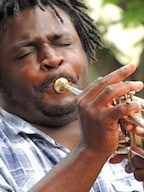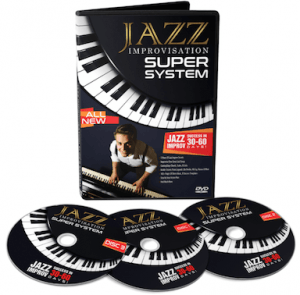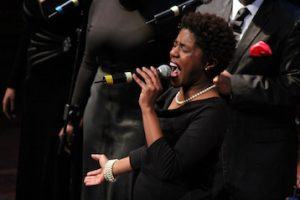Jazz Blues Scales: Simple Scale Equals Big Results
 Would you like to learn how to use jazz blues scales to play compelling improv? You’re in the right place.
Would you like to learn how to use jazz blues scales to play compelling improv? You’re in the right place.
In the video, Steve teaches a Jazz Inner Circle student one easy trick to improve to help her understand the jazz blues scales.
In this lesson, you will learn how to apply jazz blues scales in solos faster than most people. This technique is useful for all sorts of blues and jazz styles.
Take 4 minutes to watch the video above. Steve breaks down how to learn jazz blues scales fast. Then, scroll down for more step by step tips.
5 Tips To Go Deeper With Jazz Blues Scales
Now that you’ve taken a few minutes to watch the video above, let’s go further into using jazz blues scales in the improv process.
1. How To Solo Over A Tune With A Jazz Blues Scale Worry-Free
 The great thing about jazz blues scales is that they actually simplify improvisation. They’re great beginner jazz scales.
The great thing about jazz blues scales is that they actually simplify improvisation. They’re great beginner jazz scales.
Now, why is that so?
In many cases, the notes of a single blues scale will always sound good over specific chord progressions.
The two things you need to know are the key of the chord progression and the matching scale.
Let’s look into a tune like Misty to find out.
Misty is in the key of Eb. Improvise a solo over the chord changes of Misty using an Eb major blues scale.
The Eb major blues scale has the notes Eb, F, Gb, G, Bb, and C
Improvise over chord changes in a nonlinear way. Don’t just run up and down the scale.
 If you do this with a very musical sense, you’re going to hit chord tones most of the time.
If you do this with a very musical sense, you’re going to hit chord tones most of the time.
Why is that so?
Let’s look at the basic chord progression of the A section of Misty.
This particular section of Misty plays out like this:
(4/4) Ebmaj7 | Bbm7 – Eb7 – | Abmaj7 | Abm7 – Db7 – | Ebmaj7 – Cm7 – | Fm7 – Bb7 | Ebmaj7
Now let’s inspect the notes of each of the chords and see what we can find out:
Why The Jazz Blues Scale Works Perfect On Misty
Ebmaj7 – Eb G Bb D | Bbm7 – Bb Db F Ab
Eb7 – Eb Gb Bb Db | Abmaj7 – Ab C Eb G
Abm7 – Ab Cb Eb Gb | Db7 – Db F Ab Cb
Ebmaj7 – Eb G Bb D | Cm7 – C Eb G Bb
Fm7 – F Ab C Eb | Bb7 – BbD FAb
Ebmaj7 – Eb G Bb D
As you can see in the diagram above, each of the chords of Misty has at least one note from the Eb major blues scale. Targeting those notes for every chord using the scale will help you improvise sweet-sounding melodies.
So, the simplest way to improvise over chord changes is to make use of the matching jazz blues scale.
Wonderful isn’t it?
However, there’s more to jazz blues scales that you must know to succeed. Read on.
2. We Analyzed Two Jazz Blues Scales (And This Is What We Found Out)
 Jazz blues scales make it simple for you to improvise good melodies.
Jazz blues scales make it simple for you to improvise good melodies.
This is because a major jazz blues scale does not have the 4th and the 7th. The minor blues scale doesn’t have a 2nd and a 6th.
You can think of those omitted notes as a failsafe mechanism.
These notes (4ths and 7ths in a major key, 2nds and 6ths in a minor key) will sound awful when used incorrectly.
Additionally, the flat 3rd of the major version and the flat 5th of the minor version provides the bluesy sound. These blues notes also resolve to notes a half step above and sound really sweet.
With failsafe mechanisms in place, it’s easy to sound really good with the jazz blues scales.
Another crazy thing about our two jazz blues scales is that they can be used interchangeably over most blues tunes.
Let’s take a look at something like “Hippology” as performed by the Jaimoe Jasssz Band:
The tune follows a 12-bar jazz blues chord progression that goes something like this:
(4/4) G7 | G7 | G7 | G7 | C7 | G7 | G7 | D7 | Eb7 | G7 |
Listen to how each musician uses both major and minor blues scales over the same chords. Check out Bruce Katz‘s organ solo here: (By the way Bruce is one of our coveted mentors in the Jazz Inner Circle program.
Would you love to learn how to take a solo like that?
 Having a world class mentor take you step by step through the process can save you decades of struggle at the piano.
Having a world class mentor take you step by step through the process can save you decades of struggle at the piano.
That’s exactly why we created the Jazz Inner Circle….to help students build an incredible repertoire of tunes they can use to gig, go to jam sessions, write albums, tour, and build a teaching studio with.
Learn more about joining the Jazz Inner Circle here.
It’s simple. If you want to become great at anything in life you need to work with a great coach.
3. How Learning 2 Jazz Blues Scales Allows You To Play In 6 Keys
 Let’s say you already know how to play the C jazz blues scales in both major and minor versions.
Let’s say you already know how to play the C jazz blues scales in both major and minor versions.
How will two scales allow you to improvise over 6 keys?
First, let’s check out the C major blues scale. It has the notes C, D, Eb, E, G, and A.
You can already play a C major blues scale over the key of C. That’s one key already.
However, if you start your C major blues scale on A, you will instantly get an A minor blues scale. This is because A minor is the relative minor of C.
As we have learned earlier, a minor blues scale can be used over both major and minor keys.
Let’s do a simple count now. By learning a C major blues scale, you now have a single scale you can use over C major, A minor, and A major blues.
You now have a single scale that covers 3 keys.
Now, let’s say you already know your C minor blues scale which has C, Eb, F, Gb, G, and Bb.
You can already use scale this over a C minor blues tune. You can also use this over a C major blues song.
Try starting the C minor blues scale on Eb, and you will instantly get an Eb major blues scale.
So, a C minor blues scale will let you solo over C minor, C major, and Eb major blues tunes. You can now solo over another set of 3 keys.
Now, you can clearly see how mind-blowing blues scales are.
However, we can go much deeper than this. Check out the next tip.
4. How To Create A New Jazz Blues Scale
 We can’t simply stop at what we’ve talked about earlier. There’s more to know.
We can’t simply stop at what we’ve talked about earlier. There’s more to know.
Indulge me here for a bit. What if we merge both major and minor blues scales?
We can get something called a hybrid scale.
Let’s say we have C major and C minor blues scales. If we put them all together, we get this series of notes:
C – D – Eb – E – F – Gb – G – A – Bb
If you have these set of notes, you’ll get new ideas for improvising over blues tunes. The set of notes you have now will go perfectly over your I – IV – V chord progression.
You can also think of this scale as a Dorian scale with a flat 3rd.
This hybrid scale can help you get plenty of colors for your improv.
Given all this info, are you still confused about how you can improvise like a pro with these scales and modes?
 The good news is that we have taken all the confusion out of scales and modes with the Jazz Improvisation Super System.
The good news is that we have taken all the confusion out of scales and modes with the Jazz Improvisation Super System.
The Jazz Improvisation Super System is a course that teaches a systematic approach in using scales and modes for jazz and blues improv.
This method teaches you little-known scale tricks to get your fingers easily flying across the keyboard on any song you play.
You can get instant access to the courses here.
5. How Adding Extra Notes To Jazz Blues Scales Leads To Spicier Improv
 Another possibility to make your blues scale more exciting is to add some extra chromatic notes.
Another possibility to make your blues scale more exciting is to add some extra chromatic notes.
One of the most common ways of doing this is adding a 7th back to your major blues scale.
For example, you can easily add a flat 7th to a C major blues scale to emphasize that C7 chord you’re playing over.
Another example is adding that 2nd back to your C minor blues scale. The D serves to resolve nicely to the Eb of that scale.
For any of these C blues scales, you can also add a major 7th that resolves to the root note.
You can even do a chromatic passing line like Bb – B then resolving to C for a different sound.
As with anything in music, do not overdo this. Think of adding in chromatic notes to your blues scales as a spice.
A little bit of those spicy notes in your blues scales can sound magical. However, overplaying them is just a horrible mess.
So, how do you avoid such a tragedy? Find out below.
How Experimentation Can Lead To Frustration
 Have you felt disappointed with your results when you try to improvise?
Have you felt disappointed with your results when you try to improvise?
Do your improv lines still sound bland and flat?
Are you playing boring lines or wrong notes?
You may have dabbled with a couple different improv approaches in the past. Maybe some of them even sounded good inside the practice room.
However, if you’re not fully confident in what you’re doing on stage it can cause some serious stage performance issues and a lack of creativity.
It’s not a great feeling to be frustrated with your playing all the time.
The good news is that we have done all that hard work for you. There’s no need to constantly hit wrong notes anymore..
We have already identified improv techniques that work all the time on stage and in the studio.
 If you want to build a pro level repertoire and learn to improvise freely on any tune you play then you should apply for a mentorship seat in the Jazz Inner Circle program.
If you want to build a pro level repertoire and learn to improvise freely on any tune you play then you should apply for a mentorship seat in the Jazz Inner Circle program.
Are you motivated and hungry? Want to double your playing skills and revolutionize your improv skills over the next 12 months?
Then, you’re our ideal student.
Inside the Jazz Inner Circle program, you’ll discover:
- “The Ultimate Jazz Workout Training System.” This is where we implement a complete practice program to build your jazz piano talent in record time.
- Access to over 50 hours of high-level jazz intensive workshops.
- “Jazz Piano Decade In A Day Mastermind” – A full day of personal training live.
Spots are very limited. We only accept 3 student at most per month. If you’re ready to take massive action and transform your playing then apply for a Jazz Inner Circle spot here
Enjoy learning how to use jazz blues scales in improv. If you enjoyed this lesson or have something to add to the conversation, feel free to leave a comment below.
